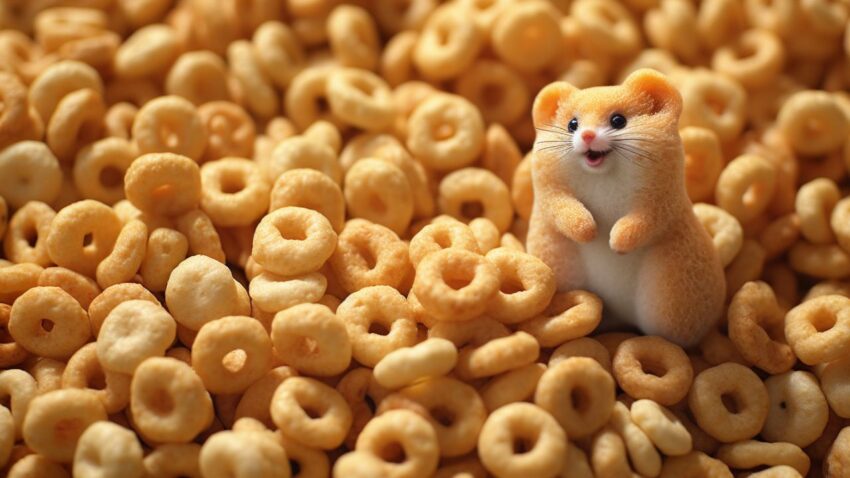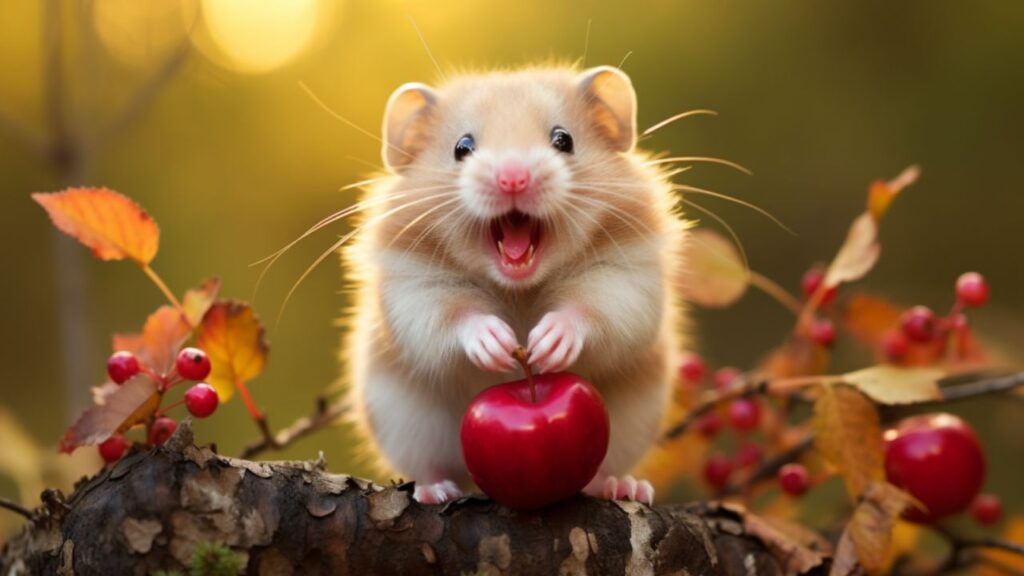TL;DR Summary
Yes, hamsters can have Cheerios, but only occasionally and in very small amounts. Cheerios are not toxic to hamsters, but they contain sugar, salt, and preservatives, which are not ideal for a hamster’s diet. A balanced diet for a hamster should primarily consist of hamster pellets, fresh veggies, occasional fruits, and proteins, with any treats, including Cheerios, making up a very small part of their overall intake. Always introduce new foods like Cheerios slowly and in tiny pieces to monitor your hamster’s reaction. Hamsters are beloved small pets, cherished for their endearing mannerisms and ease of care. As nocturnal creatures, they have a unique set of needs, especially when it comes to their diet. A hamster’s diet in the wild consists mainly of seeds, grains, and insects, but domestic hamsters often rely on a balanced blend of commercial hamster pellets, fresh fruits, vegetables, and the occasional protein boost. Their tiny bodies require a careful mix of carbohydrates, proteins, and fats, along with essential vitamins and minerals to maintain their health and energy levels.
Can Hamsters Partake in Human Snacks?
When it comes to human foods, many hamster owners are tempted to share their snacks with their pint-sized companions. It’s important to distinguish which human foods are safe and beneficial for hamster consumption and which could be detrimental. This brings us to a common household staple – Cheerios. These simple, whole-grain oat cereals are a favorite in many homes, but the question arises: Can hamsters have Cheerios? Is it a harmless treat or a potential dietary misstep? As we explore the realm of human snacks for hamsters, Cheerios is certainly a topic worth munching over.
Understanding Hamster Nutrition

When it comes to hamster health, nutrition plays a pivotal role. These small creatures may not need much food, but what they consume must be packed with the nutrients necessary for their well-being.
Basic Nutritional Requirements of Hamsters
Hamsters are omnivores, which means they require a varied diet consisting of both plant and animal matter. The ideal hamster diet is rich in variety but controlled in portions, mimicking the diversity and scarcity they would experience in the wild. A balanced diet for a hamster typically includes:
- High-quality hamster pellets: These should form the core of their diet, as they are scientifically formulated to provide balanced nutrition.
- Fresh vegetables: A source of important vitamins and minerals, fresh veggies should be offered sparingly to avoid digestive issues.
- Proteins: Occasional servings of cooked eggs, plain chicken, or mealworms can provide necessary protein.
- Whole grains and seeds: In moderation, these are excellent for energy and health.
- Limited fruits: Due to their high sugar content, fruits should be a treat rather than a staple.
- Fresh water: Always available, clean water is essential for hamster hydration.
Hamster Diet vs. Human Food
While there is some crossover between what is healthy for humans and what hamsters can eat, there are significant differences to consider:
- Sugar and fat content: Many human foods contain high levels of sugars and fats that are unhealthy for hamsters.
- Processed foods: These often contain additives and preservatives that can be harmful to hamsters.
- Spices and seasonings: Foods seasoned for human palates can disturb a hamster’s delicate digestive system.
- Dairy products: Most hamsters are lactose intolerant and cannot digest dairy products well.
It’s important to remember that the size and digestive systems of hamsters are vastly different from humans. What constitutes a small snack for us could be an overwhelming feast for them, with potentially harmful effects.
Cheerios and Hamsters

When contemplating the inclusion of human foods like Cheerios in a hamster’s diet, it’s crucial to dissect the ingredients and understand how they align with the nutritional needs of these petite pets.
Ingredients of Cheerios
Cheerios are a popular cereal made primarily from whole grain oats. The ingredient list for the original flavor is relatively straightforward, featuring whole grain oats as the main component, followed by corn starch, sugar, and salt. They also contain a few preservatives, such as tripotassium phosphate, and are fortified with essential vitamins and minerals like vitamin C, iron, and vitamin D.
Health Benefits and Risks
Potential Benefits
- Whole Grains: The whole grain oats in Cheerios can be a source of fiber for hamsters, which is beneficial for their digestion.
- Vitamin Fortification: The added vitamins in Cheerios could potentially offer a boost to a hamster’s nutritional intake, assuming the amounts align with their dietary requirements.
Potential Risks
- Sugar Content: Cheerios contain added sugar, which should be limited in a hamster’s diet to prevent obesity and diabetes.
- Salt: The sodium in Cheerios is not necessary for a hamster’s diet and, in excess, can be harmful.
- Preservatives: Chemicals like tripotassium phosphate are not part of a natural hamster diet and could potentially cause health issues.
Given the nutritional profile of Cheerios, they may not be the ideal choice for your hamster. While the occasional Cheerio might not pose a significant health risk if given as a rare treat, the cereal’s sugar and salt content, along with the presence of preservatives, make it less than ideal for regular consumption.
Whisker Tips: Feeding Cheerios to Your Hamster

As a doting hamster guardian, you might find yourself pondering whether to share a Cheerio with your furry friend. If you decide to allow your hamster a nibble of this human cereal, here are some ‘Whisker Tips to ensure you’re doing it safely and sensibly.
Proper Introduction of Cheerios into a Hamster’s Diet
Introducing new foods to a hamster should be a gradual and carefully monitored process. Here’s how you can do it with Cheerios:
- Start Small: Begin with a tiny piece of Cheerio to see how your hamster reacts, both in terms of interest and digestion.
- Observe: Watch for any adverse reactions over the next 24 hours, such as changes in stool consistency or behavior.
- Frequency: If there are no negative signs, you can offer another small piece after a couple of days have passed.
Appropriate Quantity and Frequency
- Moderation is Key: Remember, hamsters have small stomachs, and their diet should be primarily made up of hamster pellets and fresh foods.
- Size Matters: A single Cheerio should be broken into smaller pieces. Think of a Cheerio as a pizza for your hamster—slice it into tiny, bite-sized portions.
- Rare Treat: Cheerios should be given on a rare occasion, not as a regular treat. Once a week or even less is sufficient.
- Balance the Diet: Ensure that any treat, including Cheerios, does not exceed 10% of your hamster’s total diet to maintain nutritional balance.
By adhering to these ‘Whisker Tips,’ you can sprinkle a little variety into your hamster’s diet without going overboard. Treats like Cheerios can be a fun way to bond with your pet, but they should never compromise the overall nutritional integrity of their diet. Feeding your hamster Cheerios can be done, but always with a pinch of caution and a spoonful of moderation. And that’s how you keep the nibbles nifty and the diet right! Next, we’ll explore some alternative treats to keep your hamster’s palate pleased and their health in peak condition. Because remember, a happy hamster is a wheel-y happy you!
Alternatives to Cheerios

While Cheerios might be a convenient treat to grab from the cereal box, there are numerous healthier and safer options to consider when rewarding your little companion. Let’s explore some alternative snacks that will keep your hamster’s heart as full as their cheek pouches, without the unnecessary additives or sugar.
Healthier Snack Options for Hamsters
Fresh Fruits and Vegetables
- Veggies: Offer a variety of vegetables like carrots, broccoli, and spinach. These should be washed and cut into hamster-sized bites to prevent choking.
- Fruits: Introduce fruits such as apples and berries in moderation due to their higher sugar content.
- Herbs: Fresh herbs like basil or parsley can be a nutritious and flavorful treat.
Protein Sources
- Cooked Meats: Small pieces of cooked chicken or turkey can be a good source of protein.
- Eggs: Offer a small portion of hard-boiled or scrambled egg occasionally.
- Insects: For a more natural protein treat, consider occasional mealworms or crickets.
Grains and Seeds
- Brown Rice: Cooked brown rice, in small amounts, can be a wholesome grain option.
- Pumpkin Seeds: These can be a healthy and tasty treat but should be given sparingly and unsalted.
Choosing Safe Treats for Your Pet
When selecting treats for your hamster, it’s essential to consider their overall diet and the following points:
- Natural is Best: Opt for treats that are close to what hamsters would find in their natural environment.
- Check for Additives: Avoid anything with added sugar, salt, or preservatives.
- Size Appropriately: Ensure treats are small enough to prevent choking and suitably portioned to avoid overfeeding.
- Introduce Gradually: Any new treat should be introduced slowly to avoid digestive upset.
- Monitor Health: Always observe your hamster after introducing a new treat to ensure they tolerate it well.
By choosing healthier alternatives and offering them in the right way, you can enjoy the fun of treating your hamster without compromising their nutrition. With these tasty tips, you’ll be on your way to providing a banquet fit for the tiniest king of the castle! Now, let’s take a moment to whisker together a conclusion that sums up our findings and leaves you with the ultimate takeaway for your hamster’s happiness. Because, as always, a happy hamster is a wheel-y happy you!
Conclusion: The Final Nibble on Hamsters and Cheerios

In our journey through the world of hamster nutrition and the place of human foods within it, we’ve unearthed some crunchy facts about Cheerios and their compatibility with our furry friends’ diets. Let’s take a moment to digest the main takeaways and reinforce the keystones of a happy hamster diet.
Cheerios: An Occasional Hamster Treat
Cheerios, while not toxic, are not a natural choice for hamsters. They can be offered sparingly due to their sugar and salt content, as well as the presence of preservatives that do not benefit a hamster’s health. If you decide to share this oaty circle with your pet, do so rarely and in very small amounts—think of it as a special event rather than a staple of their diet.
The Cornerstone of Hamster Health: A Balanced Diet
It’s paramount that the core of your hamster’s dietary intake is balanced and tailored to their specific needs. This means:
- Commercial Hamster Pellets: These should form the majority of their diet, as they’re formulated to provide all the necessary nutrients.
- Fresh Produce: Supplement with fresh vegetables and the occasional fruit to add variety and additional vitamins.
- Proteins and Fats: Offer these sparingly. A little goes a long way in a hamster’s petite diet.
- Water: Above all, ensure your hamster has constant access to fresh, clean water.
By sticking to these guidelines, you ensure that your hamster enjoys a diet that’s not just filling their stomach but also fulfilling their nutritional requirements. As we round off our exploration, it’s clear that while hamsters can technically nibble on Cheerios, they’re better off feasting on a diet that’s been carefully curated for their tiny bodies and specific needs. Keep your hamster’s wheel spinning with joy by choosing the healthiest, most natural treats available. And with that, we come to the end of our fluffy tale. Remember, a happy hamster is a wheel-y happy you!









